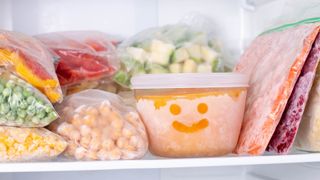Even the best freezers (opens in new tab) out there can encounter freezer burn, because it’s more about how we store food than the freezers themselves. Fear not, there are plenty of ways that you can prevent freezer burn, and learning exactly what freezer burn is and why it happens, is the first step to ensuring your food stays safe from these pesky little ice crystals. We spoke with Denise Rion, the Head of Technical from the British Frozen Food Federation to get to the bottom of what freezer burn is, what causes it, and how to prevent it from happening.
What is freezer burn?
“In generalist terms, ‘freezer burn’ is used to describe the loss of moisture from the surface of frozen foods”, explains Rion. However, it can also bring quality changes undesirable to the consumer such as the degradation of color, texture, and flavor. In more scientific terms, freezer burn is caused when water, held as ice crystals at the food’s surface, sublime (directly vaporize) into the dry freezer air, leaving behind tiny cavities. These tiny cavities increase the surface area of the food and thus it has a greater exposure to the air, and the rate of degradation is therefore increased. The time in which these undesirable quality changes develop can vary as it is dependent on several factors, such as food type, quality, packaging and packaging integrity. Every piece of food contains water, so that is nothing to be concerned about. But, the longer that food is left in the freezer, the more chance (opens in new tab) there is that the food will lose its quality and suffer freezer burn as a result. Because freezer burn is down to a dehydrating process, foods that have a higher water content are more susceptible to encounter freezer burn. So, you’ll often notice foods such as a tub of ice cream, meat and fish, or fruit and vegetables with freezer burn. How to prevent freezer burn Rion explains that unfortunately, once a food has freezer burn, there is no undoing the damage but there are ways to prevent it in the first place. The British Frozen Food Federation recommends that you follow these top 10 tips to prevent freezer burn: • Ensure that your freezer is operating at the correct temperature. The recommended temperature is around the -18°C mark, but it will still function well down to -25°C. • Seal and reseal food tightly, avoiding excess headspace before placing into the freezer. • Use high quality freezer bags or airtight containers with tight-fitting lids. • If you are storing in tubs, then choose the right size tub to fit the contents and avoid tubs which are too large. • Keep your freezer well organized and remember to label any foods that you are freezing with their details and the date that they were frozen. • Keep the freezer door closed as much as possible to avoid temperature fluctuations. Temperature fluctuations can lead to more rapid moisture loss. • Allow your food to cool properly before placing in the freezer – again, to avoid temperature fluctuations. • Take note of the storage and best before instructions on the pack. • Avoid thawing and refreezing food as this will cause moisture loss. Rather than freeing food in bulk, try freezing in smaller portions. • Keep an eye on how long frozen items are left out of the freezer to prevent too much fluctuation in their temperature. You should also try to eat your food as soon as possible after storing it. Although the great part of freezing food means that you can enjoy it at a later date, and avoid food waste, although slowly, the quality of the food will deplete over time. Discover more guides for the home… Best front load washers (opens in new tab) Best top load washers (opens in new tab) Best dryers (opens in new tab) Best dishwashers (opens in new tab) Best french door refrigerators (opens in new tab)







